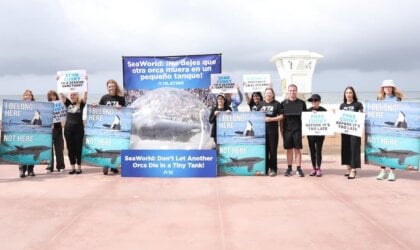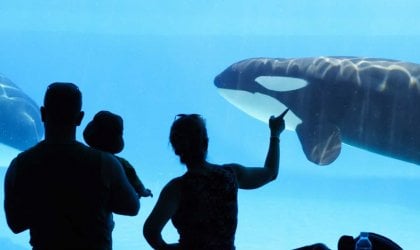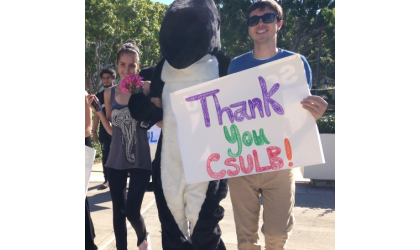SeaWorld has applied to the California Coastal Commission to build marginally bigger tanks as part of the company’s Blue World Project, but it’ll never be able to construct tanks that allow orcas to swim even close to the distance they would in the wild. An enriching environment is crucial to orcas’ well-being, and tanks deprive them of the physical and mental stimulation that the ocean would naturally provide.
Here are some big problems with SeaWorld’s proposed Blue World tanks:
1. The orcas still won’t be able to dive.
In the wild, orcas dive up to 1,000 feet, while the tanks that SeaWorld has proposed will only reach 50 feet. That’s 950 feet that they still won’t be able to dive. This is an increase of only 15 feet—which is shorter than the length of a single adult orca—from the current tank depth of a meager 35 feet.
2. The tanks come up short.
SeaWorld’s proposed new tanks are only 350 feet long (or 0.07 mile). In the wild, orcas may travel up to 100 miles everyday. One orca pod has even been observed swimming nearly 138 miles.
In order to swim that distance in SeaWorld’s new tanks, the orcas would have to swim more than 1,500 lengths back and forth each day.
3. The orcas can’t wait.
In the last 10 years, seven orcas owned by SeaWorld have died at an average age of less than 13, whereas orcas in the wild have an average life expectancy of 30 to 50 years—and some can even live to be more than 100.

A recent paper written by two former SeaWorld trainers in the journal Marine Mammal Science revealed that the median survival estimate for captive orcas in the U.S. is just 12 years and that 63 percent of whales who’ve died in captivity spent less than six years in tanks before their death.
4. The tanks do not support natural orca behavior.
As an alternative to tanks, renowned orca experts have suggested constructing a coastal sanctuary or a sea pen, which would allow the orcas to live in the ocean once again.
In seaside sanctuaries, they could still be monitored and cared for, but they would be able to feel and experience the ocean and interact with other marine life—a far cry from the chemically treated water of SeaWorld’s tanks.
#SeaWorld is doing so bad, analyst thinks they should shut down & sell their #Orlando location http://t.co/jT3po2D00W pic.twitter.com/DA98CGyBc8
— PETA (@peta) September 15, 2015
5. The tanks waste money that could be used for conservation.
SeaWorld is projecting to spend $95 million on the construction of the tanks in its proposed Blue World development, but coastal sanctuaries or sea pens could be created for a fraction of that amount and save tens of millions of dollars that could be used to help care for the orcas. The new tanks will cost more money than what SeaWorld is projected to spend on rescue and conservation in 13 years.
6. The public doesn’t support the tanks.
SeaWorld lost 1 million visitors last year, and more than 100,000 PETA members and supporters have urged the California Coastal Commission to vote against its plans to keep orcas in artificial tanks.
If SeaWorld honestly cares about the well-being of its orcas, it should cancel its Blue World Project plans and invest in coastal sanctuaries where marine mammals can feel and experience the ocean.
Learn more about cruelty at SeaWorld on The PETA Podcast:
Listen to more episodes on iTunes, Stitcher, and Spotify! Subscribe for new episodes.
If you don’t support confining orcas to concrete prisons, please tell the California Coastal Commission to vote AGAINST SeaWorld’s Blue World Project!




